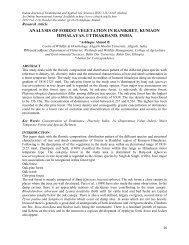Caudal regression syndrome - CIBTech
Caudal regression syndrome - CIBTech
Caudal regression syndrome - CIBTech
Create successful ePaper yourself
Turn your PDF publications into a flip-book with our unique Google optimized e-Paper software.
International Journal of Basic and Applied Medical Sciences ISSN: 2277-2103 (Online)<br />
An Online International Journal Available at http://www.cibtech.org/jms.htm<br />
2011 Vol. 1 (1) September-December, pp.126-130/Gehlot and Mandliya<br />
Case Report<br />
deformation. The most severe types involve a total absence of the sacrum and distal lumbar vertebrae.<br />
The exact etiology is unknown but appears to be due to intrauterine insult before 4<br />
Figure 4: Sagittal T2 weighted image of pelvis showing abnormal thickening of wall of urinary<br />
bladder with few small diverticulae. Also noted are normal uterus, rectum and anal canal.<br />
weeks of gestation which could be toxic, ischemic or infectious. Other possibilities could be injury to<br />
notochord or abnormality of glucose transporter genes. There is a definite association with maternal<br />
diabetes and a sixth of cases of caudal <strong>regression</strong> <strong>syndrome</strong> have diabetic mother. Proper control diabetes<br />
before conception and in first eight weeks of gestation significantly reduced the chances of the anomaly<br />
[Kassai 2008].<br />
Detailed clinical examination and radiological investigations are essential for proper management of<br />
condition. Myelography and CT myelography has been replaced by MRI as gold standard [Kahilogullari<br />
2005] as it can provide details of almost all the anatomical abnormalities associated with the condition.<br />
Lumbosacral hypogenesis is frequently associated with genitourinary and gastrointestinal anomalies<br />
named as OEIS (omphalocele, cloacal exostrophy, imperforate anus and spinal deformity) and<br />
VACTERL (vertebral anomalies, anorectal malformation, cardiac malformations, tracheooesophageal<br />
anomalies, renal agenesis and limb abnormalities) <strong>syndrome</strong>. Hypoplastic anomalous distal cord is seen in<br />
almost all case of sacral agenesis predominantly ventrally resulting in blunted wedge shaped terminal end<br />
of cord. Tethering of cord is a common associated anomaly more commonly seen in milder forms of<br />
hypogenesis and in such case the terminal cord is not blunted but elongated like typical tethered cord<br />
[Barkovich 2005]. Clinically, patients with milder abnormalities have motor and sensory deficits,<br />
sphincter disorder and almost always neurogenic bladder. In cases of sacral agenesis tip of conus located<br />
below L1 level is almost always suggestive of tethering [Pang 1993]. Progressive neurological complains<br />
129

















